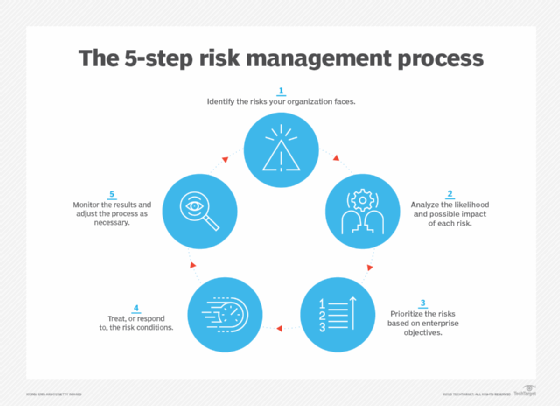The Impact of the Importance of Risk Management on Organizational Governance
The Impact of the Importance of Risk Management on Organizational Governance
Blog Article
Exploring the Relevance of Risk Management for Effective Decision-Making Methods
In the detailed globe of business, Risk Management becomes a crucial factor in the decision-making procedure. The capacity to determine possible risks and possibilities, and strategize accordingly, can lead to the difference in between success and failing. With tools such as SWOT and PESTEL, companies are geared up to make enlightened choices, promoting strength and adaptability in an ever-changing setting. Wondering exactly how this functions? Allow's unpack the dynamics additionally.
Recognizing the Idea of Risk Management
Risk Management, a vital element in decision-making, is usually misconstrued or oversimplified. Usually, it refers to the identification, evaluation, and prioritization of risks to decrease, check, and control the probability or impact of unfavorable events. Nevertheless, it's not simply regarding protecting against unfavorable results, however additionally concerning acknowledging possible chances. Risk Management involves structured and disciplined strategies, utilizing information and insightful analyses. It needs an extensive understanding of the company's context, goals, and the potential risks that can obstruct them. From financial unpredictabilities, legal liabilities, critical Management errors, to crashes and natural calamities, it attends to various threats. Significantly, effective Risk Management is not stationary; it's a continuous, progressive process that advances with altering situations.
The Function of Risk Management in Decision-Making Processes
In the world of critical preparation and organization operations, Risk Management plays an essential function in decision-making processes. Risk Management therefore becomes a vital tool in decision-making, assisting leaders to make enlightened selections based on an extensive understanding of the threats involved. Risk Management serves as a vital part in the decision-making procedures of any type of organization.

Just How Risk Management Improves Strategic Preparation
In the context of tactical preparation, Risk Management plays a pivotal function. Launching with the identification of possible dangers, it additionally includes the execution of Risk mitigation actions. The function of Risk Management is not fixed yet vibrant, as it demands consistent tracking and adjusting of techniques.
Identifying Possible Risks

Executing Risk Mitigation
Risk reduction techniques can vary from Risk evasion, Risk transfer, to take the chance of reduction. Each strategy find out here needs to be tailored to the details Risk, considering its potential influence and the organization's Risk resistance. Effective Risk mitigation requires a deep understanding of the Risk landscape and the potential impact of each Risk.
Monitoring and Readjusting Approaches
Though Risk mitigation is an important action in tactical preparation, constant monitoring and change of these techniques is similarly essential. This ongoing process permits organizations to identify new dangers and reassess existing ones, making certain the implemented approaches remain reliable in the ever-changing business environment. It additionally supplies a chance to assess the success of the Risk Management actions, enabling changes to be made where necessary, additional enhancing tactical preparation. Reliable monitoring and change require the usage of analytics and vital efficiency signs (KPIs) to measure effectiveness. These devices provide important data-driven why not find out more understandings that can inform tactical decision-making. As a result, monitoring and changing Risk Management methods is a critical element for boosting an organization's resilience and tactical planning.
Situation Studies: Successful Risk Management and Decision-Making
In the globe of company and finance, effective Risk Management and decision-making commonly serve as the pillars of flourishing ventures. These instances highlight the value of sharp Risk Management in decision-making procedures. These cases underscore the vital duty of Risk Management in critical decision-making.
Tools and Strategies for Efficient Risk Management
These tools, such as Risk registers and heat maps, aid in identifying and assessing potential risks. Risk response strategies, a key element of Risk Management, involve accepting, avoiding, transferring, or mitigating risks. With these tools and methods, decision-makers can browse the complex landscape of Risk Management, therefore helping with notified and reliable decision-making.
Future Trends in Risk Management and Decision-Making Techniques
As we check out the vast landscape of Risk Management, it becomes noticeable that the strategies and tools used today will proceed to progress. The concept of Risk society, where every member of an organization is conscious and included in Risk Management, will gain extra importance. These patterns advertise an even more aggressive and inclusive approach towards Risk Management and decision-making.
Verdict

Risk Management thus ends up being an essential tool in decision-making, assisting leaders to make educated selections based on a thorough understanding of the threats included. Risk mitigation methods can vary from Risk avoidance, Risk transfer, to take the chance of reduction (importance of risk management). Efficient Risk reduction requires a deep understanding of the Risk landscape and the prospective impact of each look at this now Risk. Risk response approaches, a vital element of Risk Management, involve approving, preventing, moving, or mitigating dangers. The concept of Risk society, where every participant of a company is conscious and included in Risk Management, will certainly gain more importance
Report this page